Tag Archives | africa
How crab lost his head
In February I drew a cover for How Crab Lost His Head. It’s out in October, I did the illustrations in it too.
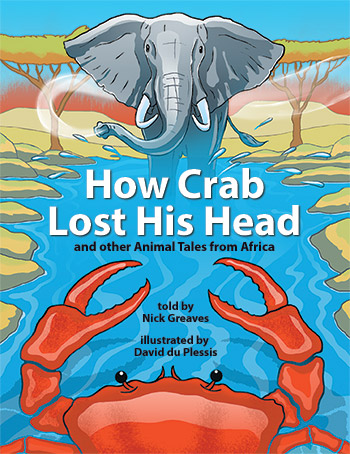
Mister Sengi’s Very Big Friend wins award
Mister Sengi’s Very Big Friend wins a Bookchat Award for 2013.
Which is a pleasant surprise, but also an honour as there are some big names on the list.
Fiction
- MISTER SENGI’S VERY BIG FRIEND by David du Plessis & Charles de Villiers (Struik Nature 2013)
- MONDAY EVENING, THURSDAY AFTERNOON by Jenny Robson (Tafelberg 2013)
- SHARP EDGES by S A Partridge (Human & Rousseau 2013)
- SISI GOES TO SCHOOL and other stories by Wendy Hartmann, illustrated by Joan Rankin (Human & Rousseau 2013)
- STORYTIME : 10 South African stories for children by various authors (Sunday Times/Nal’ibali 2013)
- THE NAME OF THE TREE IS BOJABI by Dianne Hofmeyr, illustrated by Piet Grobler (Human & Rousseau 2013)
Non-fiction
- FIRST FACT FINDER by Helen Lewis (Metz Press 2013)
- SAM, The Toad in the Hole by Lulu & Tee (African Penguin 2013)
- MISTER SENGI’S VERY BIG FRIEND by David du Plessis & Charles de Villiers (Struik Nature 2013)
- MONDAY EVENING, THURSDAY AFTERNOON by Jenny Robson (Tafelberg 2013)
- SHARP EDGES by S A Partridge (Human & Rousseau 2013)
- SISI GOES TO SCHOOL and other stories by Wendy Hartmann, illustrated by Joan Rankin (Human & Rousseau 2013)
- STORYTIME : 10 South African stories for children by various authors (Sunday Times/Nal’ibali 2013)
- THE NAME OF THE TREE IS BOJABI by Dianne Hofmeyr, illustrated by Piet Grobler (Human & Rousseau 2013)
Non-fiction
- FIRST FACT FINDER by Helen Lewis (Metz Press 2013)
- SAM, The Toad in the Hole by Lulu & Tee (African Penguin 2013)
Mister Sengi’s Very Big Friend first review… and the serval

Mister Sengi’s Very Big Friend by David du Plessis & Charles de Villiers (Struik Nature 2013) is book of the month on Bookchat. Jay Heale writes:
An animal picture book story about size and safety in the bushveld, with the details remaining true to nature. Sengi is an elephant shrew (that’s what a ‘sengi’ is) whose new friend Tortoise tries to take him to meet a real elephant. On the way they encounter the dangers of a Hornbill and a Serval – and having a Very Big Friend comes in handy. Sensible, enjoyable text with some superb artwork. Computer graphics used as art. Soft graded colour-washes in the background, stylised grasses, clearly outlined main characters. I loved the way that the tortoise’s shell (and the Moon) suggested a map of the world. This is quality stuff, with atmosphere, character, drama (the first appearance of the serval is magnificently menacing) and still a splendid story for children 3 to 8.
How the serval came to be
Now that reviews are appearing I’m thinking about the amount of work it takes to create a picture book. A sane person wouldn’t attempt it. But it’s the drawings themselves that inspire you to keep working, and when they emerge fully formed you know you’re on the right track. About halfway through the book I met Mister Serval in Charles’s evocative writing ‘with his neat whiskers and his big ears sticking straight up like a top-hat’.
So I sketched him like this,
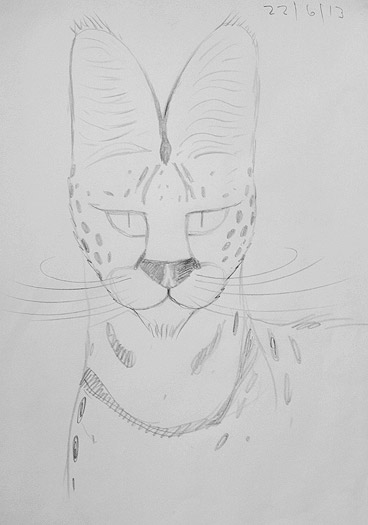
and then all that remained was adding colour,

he is one of the stars of the show!
I’m lucky to have the opportunity to do this.
Mister Sengi’s Very Big Friend
The mopane bushveld of southern Botswana is a magical place. This is how I remember it:
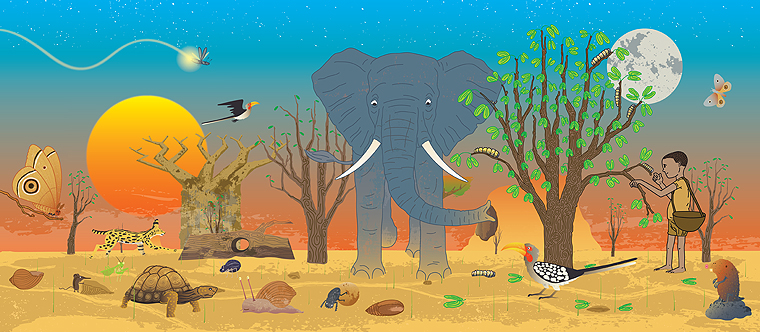
orange-yellow rust coloured earth – scraggly mopane trees with leathery butterfly shaped leaves – abandoned shells of giant land snails – trees snapped at the base by rambling elephants – rhino dung set upon anxiously by tribes of dung beetles – southern yellow-billed hornbills gliding in wide arcs from tree to tree – baobab trees towering above the bushveld scrub, ancient and otherworldly – the sound of a startled leopard’s nails gripping dry tree bark – the crimson African sunsets – abandoned ant hills excavated by aardvarks…
And that’s only a fraction of what’s on show in daylight; after dark everything changes when a cast of noisy and unusual characters wake up: bushbabies, aardvarks, pangolins, giant crickets, nightjars.
All the buzzing bush activity made me curious so I decided to explore on my own (not a good idea in the wild) – risking it down an overgrown footpath on the banks of the Limpopo River. I was on high alert for something big and potentially angry, but instead, I was startled by a tiny creature racing across the footpath. It stopped suddenly, hiding in the shade under a nearby shrub. I peered into the shadows and slowly an elephant shrew, or sengi, came into view, looking something like this:
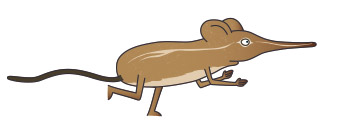
We froze – sized each other up and waited – then he, or she, was gone.
The result of that day is a new book, Mister Sengi’s Very Big Friend. It is the story of an elephant shrew who wants to see the world through the eyes of something much bigger than himself.

A number of story iterations, and many drawings later, the tale was beautifully captured and written by Charles de Villiers. The book is scheduled to appear in December 2013.
It is available in English and Afrikaans from Kalahari.com. You can also buy it as an ebook.
Activity Books
My first activity books will be published in May 2013.

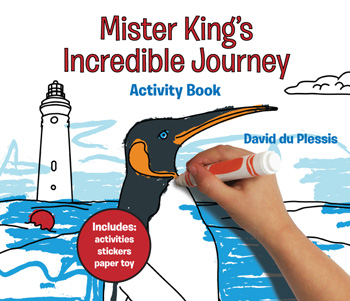
Visit the companion website to the books at www.activitiesforafrica.com and download additional free activity templates.
Mister King’s Incredible Journey
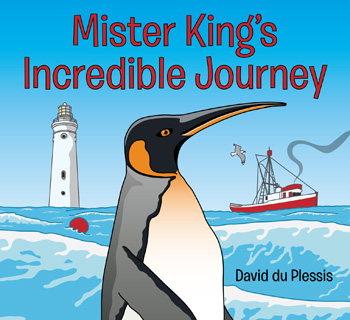
I’ve been asked more than once whether the events in the book, when Mister King arrives on the beach and thereafter, really happened. The story combines elements of experience, fact and fiction.
My grandfather passed away in 2009, he was the last remaining link I had to Cape St Francis, a small village on South Africa’s east coast. A flood of memories followed, the most vivid being of my grandmother and her love for the sea.
She told me that, early one morning, she came upon an albatross sitting on the beach, it wasn’t afraid of her, she recalled that it had the most beautiful eyes. The phone would then start ringing at the Port Elizabeth aquarium and she passed the information on. She believed such events were significant.

The lighthouse at Cape St Francis.
As a child our family spent summer holidays at Cape St Francis. The lighthouse fascinated me and I’d roam about the rocks at its foot for hours. Cape St Francis is renowned for rough seas and storms regularly carry debris from boats and the deep onto the rocks, including exhausted penguins clinging on to life. Frequent visitors were African Penguins from Cape Town, but one day I came upon a tall penguin with distinctive orange markings at the side of its head.
I told my grandmother about this and she in turn spoke to the other locals, a number of theories developed in an attempt to explain how the stranger arrived at the lighthouse. The one I liked best ran like this: fishermen capture penguins on remote islands and take them onto their boats, and when they grow tired of them the penguins are thrown overboard (that is if they don’t end up as lunch).
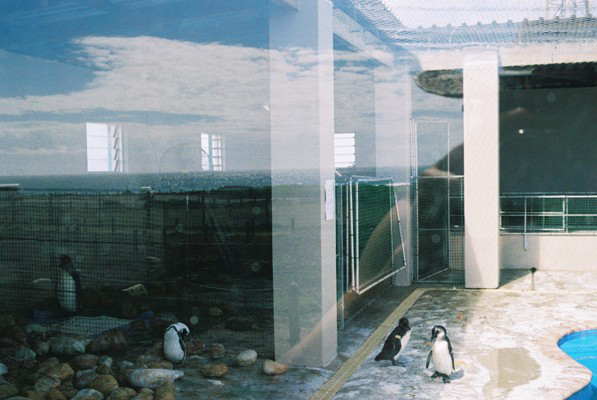
The Penguin Sanctuary at Cape St Francis in 2007. A King Penguin (far left) standing in the shade with his back towards a fan.
On my last visit to Cape St Francis in 2007 I walked out to the lighthouse where a penguin sanctuary had recently been built. In the shadows, at the side of the pool, a lone King Penguin stood motionless under a fan to keep cool. My grandmother had already passed away at that time which is probably the reason why the memories surfaced with such poignancy years later when I was living in London.
King Penguins are still arriving at Cape St Francis, the story continues …
